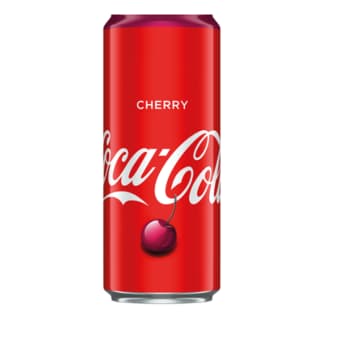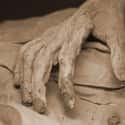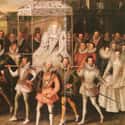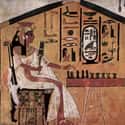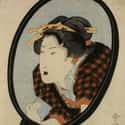-
(#1) British Nobles Built Elaborate Fake Castle Ruins Complete With Fake Hermits
In the 18th and 19th centuries in the United Kingdom, building a "folly" was all the rage for the rich and famous. What’s a folly? It’s a massive structure - think giant, ivy-covered castle ruins - built entirely for non-serious purposes like entertaining rich guests. Party-goers at the homes of nobility had the opportunity to tour and play in the follies, and most follies had their own “legends” attached. Some follies even had “hermits” living in them who were paid to jump out and scare guests with their gnarly, wizened visages.
Other than the exorbitant expense of building and maintaining a folly (which is what made it a status symbol), the whole concept doesn’t sound so different from the living history demonstrations and cosplay people love to participate in today.
-
(#2) Wealthy Victorians Would Buy Mummies To Unwrap At Dinner Parties
Those Victorians really knew how to show off with panache. During 19th century England's “Egyptomania” phase (where everyone was basically obsessed with all things ancient Egypt), one of the more macabre methods of showing your status was your ability to purchase an Egyptian mummy to have on display at gatherings at your home. The really well off didn’t just purchase mummies to display them, either. They would host elaborate “unwrapping” parties where their guests had the unique opportunity to watch as millennia-old corpses were unwrapped in front of them.
-
(#3) Chinese Women Had Their Feet Crippled As A Status Symbol
For nearly ten centuries, if you were a woman who wanted to marry into money in China, then you submitted to the unbelievably painful practice of foot binding. Foot binding - which left its practitioners with so-called “lotus feet” - involved breaking the toes and bones of the arch and binding them tightly together from the time a girl was around 7 years old until adulthood. Lotus feet, which are about three inches long, signified both beauty and status. The thinking behind the symbols goes, if you can submit to a process that will render you unable to really walk or work, you must come from a family wealthy enough for your labor not to matter. The practice actually had to be nationally outlawed in 1912 in order to get people to stop doing it.
-
(#4) Frivolous X-Rays Were A Rich Man's Hobby At The Turn Of The Century
If you wanted to demonstrate both your status and your eccentricity, there was no better way to do it than by getting x-rays taken of your body. At least this was the case in the United States in the early twentieth century. X-rays would be performed as public spectacles, with crowds gathering around the ingenious machine, anxious to get a glimpse of someone’s bones. The resulting images were often framed and hung on the walls, like oil paintings might have been in years past. But just seeing an x-ray performed wasn’t enough for the true seekers of status. Owning your own, personal x-ray machine was the real mark of a cultivated connoisseur.
-
(#5) Tulips Were Big Business - Until A Flower Market Crash Tanked The Economy
Historians refer to the 1630s in Holland as the heyday of “tulipomania” in the country. Basically, the history of the tulip as a major status symbol in Holland began when tulip bulbs first arrived there in 1562 after (it’s rumored, at least) an Austrian ambassador stole them from the Ottoman court. Their beauty and colorfulness, combined with the rarity of tulips, made them a status symbol reserved for only the wealthiest in the country. At the apex of tulipomania, a single tulip bulb could be sold for as much as ten times the yearly salary of a skilled craftsman... while it was still in the ground! However, the tulip market crashed in 1637, completely devastating the Dutch economy.
-
(#6) Being Overweight Meant You Could Afford Rich Food And A Life of Leisure
It may be surprising to learn that the expression “fat cat" (which is now used to refer to moneyed, slimy-but-powerful members of the elite) has somewhat literal origins. Weight, especially possessing lots of it, stood for a long time as a symbol of status and prosperity. If you could afford to be overweight, you obviously had enough money to buy sumptuous food, and you had the ability to avoid manual labor.
Weight as a status symbol basically clung on until the early twentieth century when, for the first time in the West, plentiful food supplies become relatively abundant even for the lowest members of the social hierarchy. Today, when cooking healthful food and going to the gym requires more leisure time and money, thinness has become a status symbol instead.
-
(#7) Pineapples Were The Caviar And Cristal Of The 18th Century
Do you ever look at the pineapple in your fruit salad, lean back, and muse on the empowering feeling of your high status as represented by your lunch? Probably not, since it’s not the eighteenth century. However, back then, owning a pineapple was pretty much the peak of luxurious living. You see, pineapples are native to South America and were unknown to Europeans before Columbus’s foray into the “New” World. When Columbus returned with pineapples in his cargo, aristocratic Europeans fell in LOVE, but they didn’t yet know how to cultivate the strange fruit. As a result, a single pineapple was worth the equivalent of around $8,000 in contemporary money, and party hosts would even rent a pineapple for a single night to have on display in order to dazzle their guests.
-
(#8) Cultures All Over The World Valued Long, Flat Heads
Nothing could up your profile in the ancient Mayan world faster than some good old-fashioned cranial deformation. Cranial deformation - AKA skull alteration - is achieved by binding babies’ heads between two boards while their skulls are nice and malleable in order to make their heads appear more “noble” (as well as long and flat).
A Mayan practitioner of cranial deformation told Gonzlo Fernández de Oviedo, a Spanish chronicler, that his Mayan “ancestors were told by the gods that that if our heads were thus formed we should appear noble and handsome and better able to bear burdens.”
Notably, cranial deformation as a status symbol is a cross-cultural, cross-continental practice. The Mangbetu Tribe of the Democratic Republic of the Congo practice something similar, as did the Huns, Aborginal Australians, some Native American tribes, and many other people throughout the world.
-
(#9) High-Class Brides Showed Off With A Pure White Wedding Cake
In sixteenth-century England, simply possessing enough sugar to make a cake was no longer enough of a status symbol for the truly wealthy because sugar had become too readily available. As a result, if you wanted to really stunt, you sent your daughter off with a pure white wedding cake, comprised of triple-refined white sugar (not the cheaper light brown stuff). This makes sense, since triple-refined was the most difficult and expensive sugar to produce. Using triple-refined sugar to make a pure white cake was also pretty expedient for wealthy families because along with showcasing their wealth it also stood as a symbol of the bride’s chastity and purity.
-
(#10) Ancient Egyptians Played Very Fancy Board Games
Nothing quite said status like owning a board game in the ancient Near East. At the time, incredibly ornate and beautiful board games were used as diplomatic gifts, things the elite gave to one another to signify mutual status in places like Iraq, Egypt, Turkey, and Syria. Not only were the board games themselves expensive - a work of careful craftsmanship made with pricey materials - but they also indicated another essential feature of class: the leisure time to be able to play them.
-
(#11) Wealthy Asian Women Once Blackened Their Teeth To Impress
It’s no doubt that having “perfect teeth” is seen as an indicator of status even today. And today the lengths that people will go to to have the whitest pearly whites are pretty insane. However, this wasn’t always the case. In fact, black teeth were the preferred look for the wealthy in Japan, China, and Southeast Asia for hundreds of years. Married women of some means were the major practitioners of tooth blackening. Notably, this process of lacquering the teeth black (also known as ohaguro) actually functioned as a dental sealant, helping the affluent avoid tooth decay.
-
(#12) Pure White Cuffs And Collars Meant You Could Afford To Stay Clean
One way to prove your superiority in sixteenth- and seventeenth-century England was by paying careful attention to keeping your whitest whites FLAWLESS. Clean clothes signified a clean mind and body, while also indicating a person’s status. So, in order to prove his inner and outer cleanliness, a wealthy Tudor would rock a pristine white collar and white cuff. This is why portraits of rich families from that time period almost always show men with visible white cuffs and collars.
-
(#13) Von Dutch Trucker Hats Were So Low Class They Were High Class Again
Oh, the early 2000s. It was the time of Britney Spears’s breakdown; it was LiLo’s moment in the sun; it was the moment for some wonderfully strange status symbols. Along with Juicy Couture sweatsuits, a Von Dutch trucker hat was a must-have item for the high-status set. It could be seen on the heads of Nicole Richie and Paris Hilton on The Simple Life. Ashton Kutcher pretty much never left his house without one. The LA Times even ran a feature article on the Von Dutch phenomenon in 2004, referring to them as the “anti-status status symbol” of the moment.
-
(#14) In The US Today, Being Too Busy To Sleep Means Your Time Must Be Pretty Valuable
In the United States, those who want to show off their high status go back and forth between doing so through a lack of sleep or an overabundance of it. Sometimes, busyness, as shown through harried, blood-shot eyes, is the way to demonstrate your worth and importance. Other times, it’s through your ability to attain a restful night’s sleep. According to Nancy Jeffrey, a staff reporter for The Wall Street Journal, in 1999, sleep had become such a “rare commodity in stressed-out America” that it was “the new status symbol.” Let’s bring that back!
New Random Displays Display All By Ranking
About This Tool
There will be obvious or unobvious hierarchies throughout human history. Human beings always like to treat people differently according to their own preferences and wealth. Ascending to the national and cultural level, it becomes a hierarchy, and related status symbols or objects also appear. Whether it is the European royal family and aristocrats in the Middle Ages or the ancient Chinese feudal dynasties, the marks of power and status can be seen everywhere, the most obvious of which is clothing.
Do you know any famous status symbol objects? The random tool lists 14 of the most ridiculous and divine status symbols from different eras, for example, during the Victorian era, wealthy aristocrats were keen to buy mummies and display them at dinner parties.
Our data comes from Ranker, If you want to participate in the ranking of items displayed on this page, please click here.






